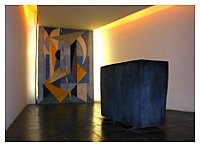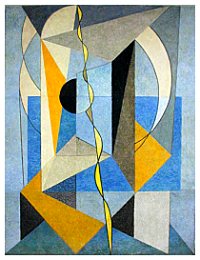|

by Edith Kermit Roosevelt
The New Hampshire Sunday Times News
October 21, 1962
from
ConspiracyArchive Website
Unwrapping her gauzy veils a "White
Madonna" danced on the podium. She symbolized "Christianity" or the
"Mother of the World encompassing forms of the creative feminine
spirit which has unfolded over the centuries from Egypt, Babylonia,
China and Europe," said a program distribute at the Temple of
Understanding's benefit dinner.
The dinner, held Oct. 12 at the Waldorf Astoria, featured this
dramatic skit on "Christianity" and five other skits on the major
faiths to commemorative $5,000,000 Temple to be built on 50 acres by
the Potomac River, Washington, D. C.
The Temple brochure describes the edifice as a "Spiritual United
Nations" designed to fulfill the rituals of the six major faiths and
replace "nationalist limitations" with "universal understanding" for
"citizens of the world!"
PUBLICISTS for this tax-exempt "Project Understanding" claim support
from the "pennies donated by hairdressers, taxicab drivers and
workers all over the world." But judging from the Temple's printed
list of sponsors it can count on more influential backing.
For
instance:
-
John D. Rockefeller IV
-
Socialist leader Norman Thomas
-
Rt. Rev. James A. Pike of San
Francisco
-
Cary Grant
-
Defense Secretary Robert S.
McNamara, a founding member of the Fund for the Republic's
Center for Democratic Institutions
-
Militant pacifist and Nobel
Peace Prize and Nobel Peace Prize winner Philip Noel Baker
-
Holland D. Roberts of the
Academic Freedom Committee, a former head of the Communist
party's California Labor School who was identified as a
"party member" at a Jan. 22, 1956 hearing of the Subversive
Activities Control Board
-
U. Alexis Johnson, depute
undersecretary of state for political affairs
-
Sen. Kenneth B. Keating (R-N.Y.),
Prof. Pitirim A. Sorokin, director of Harvard University's
Research Center for Creative Altruism and Brooks Hays,
special assistant to President Kennedy
AT THE WALDORF'S Starlight Roof I heard
Mrs. Dickerman Hollister, president of the Temple of Understanding
(P.O. Box 191, Greenwich, Conn.), address some 500 UN delegates and
socialites. In a voice choked with fervor, she said:
“We are sending an idea to create a
global symbol of the world.”
Then she struck with a wand an egg held
aloft by a child. Out popped a "magic" golden tree with six branches
on either side.
THE SYMBOLISM is not surprising in view of the mystic appeal of the
internationalist dream. For example, one of the
Temple
sponsors is Roland Gammond, former director of the Laymen's
Movement, World Parliament of Religions. This international,
non-sectarian group of big businessmen, psychiatrists and other
professional men meet in the seclusion of Wainwright House, Milton
Point, Rye, N. Y., to study
scientific mind control.

I secured the texts of some of the Wainwright House seminars which
treat of such topics as "clairvoyance," "automatic writing,"
"hallucinations," "religion as part of an enlarged science" and "the
psychic content of the alchemical symbols."
According to this year's Sept.-Oct. issue of the Laymen's Review
published at Wainwright House, the Movement "spearheaded" the
establishment of the UN Meditations Room which happens to contain
some of those "alchemical symbols."
THE UN MEDITATION Room mural is divided into 72 separate
sections—the tetragrammaton or Divine Name of 72 words. It depicts
triangles and pyramids representing "the deity" in accordance with
the ancient Babylonian symbols. Also a part of this mural is a
spiral figure intertwined with a diagonal line which may represent
Hermes' wand, the Cadeuces, traditional symbol of the sex forces or
Kundalini.
The mural's center sphere and outer circle roughly form an eye. The
"all seeing eye" of the deity theme is to be repeated in the Temple
building by a glass eye faceted like a diamond to reflect the rays
of the sun through the six wings.
IT IS INTERESTING to note that the Interparliamentary Union — Temple
of Understanding sponsor Sen. Keating is IPU secretary — adopted a few
weeks ago as its emblem:
"A Temple of Law with six columns
for the six continents to show the Universality of the Union."
The IPU, which has been financed in part
by the tax-exempt Carnegie Endowment for International Peace,
consists of a training corps of legislators who meet regularly with
their Communist "counterparts" to set up a world parliamentary
government.
While some people may dismiss these humanistic temples as another
example of "goofy" internationalism, apologists for Moscow view them
as a serious component in their drive to promote the "Social
Gospel."
Two temple sponsors are included in the Senate Internal Security's
"list of the most typical sponsors of front organizations" published
April 23, 1956.
They are:
-
Jerome Davis, New Haven, Conn.,
educator who heads Promoting Enduring Peace, a group whose
literature whose literature is distributed by the Arcane School
(operated by the tax-exempt "non-political" Lucis Trust on the
32nd and 33rd floors of 11 W. 42nd St., N. Y.) The international
Lucis Trust network, which has substantial financial backing,
regularly holds "Full Moon Meditation Meetings" at the Carnegie
Endowment for International Peace to promote UNESCO and the "New
World Religion."
-
Prof. Kirtley Mather of the Geologic
Museum, Cambridge, Mass., who has served on a four-man panel
evaluating "physical research" at Wainwright House.
-
ANOTHER TEMPLE backer is Rev. Lee H.
Ball, executive secretary of the Methodist Federation for Social
Action, an organization cited as a front by the Senate Internal
Security Subcommittee on April 23, 1956.
On July 7, 1953, Ben Gitlow, former secretary of the Communist party, testified under
oath that Ball was one of "the principle individuals involved in
the Communist conspiracy to subvert the church for Communist
purposes."
Shouldn't they add the hammer and sickle
symbol to the second "Meditation Room" slated for the new
Washington Temple?
|
"A Room of Quiet"
The Meditation Room
United Nations
Headquarters
from
UN Website
In the original plan for the new Headquarters, a tiny
room had been provided as a place dedicated to silence,
where people could withdraw into themselves, regardless
of their faith, creed or religion, but Dag Hammarskjöld
wanted something more dignified. In his efforts he was
supported by a group, composed of Christians, Jews, and
Moslems, the "Friends of the UN Meditation Room", who
combined their efforts and provided the money for a room
worthy of a world organization.
The work on the room began, and Mr. Hammarskjöld
personally planned and supervised in every detail the
creation of the "Meditation Room".

Meditation Room,
United Nations Headquarters

Abstract mural in the Meditation
Room by painter Bo Beskow
An example of his interest
is reflected in this exchange of correspondence in
Swedish regarding the design of the fabric to be used
for the carpeting. The letter by Dag Hammarskjöld is
translated.
Journalist Pauline Frederick gave another example of
this interest in an interview for the UN Oral History
Collection.
"He was instrumental
in creating what he called the Meditation Room. He
said that "This House" - which he referred to the UN
frequently... - This house must have one room
dedicated to silence... I remember very distinctly
one night, when I heard that he had been working
most of the night, and about two o'clock in the
morning, he called some of his aides in, and they
assumed that there had been some bad news from one
of the fronts where the United Nations Emergency
Forces were then located, but he said, "I want to go
down to the Meditation Room."
And he took them down
to the Meditation Room, and it was about, as I said,
two o'clock in the morning, and there he spent
considerable time directing the painters to put just
the precise coat of paint on the walls of that
Meditation Room, so the light would be just as he
wanted it. So he had a very close feeling about the
spiritual. And he felt that it should be the center
of the United Nations. He had a special crew of
painters working on the Meditation Room that
evening.
He said, "We want to
bring back, in this room, the stillness which we
have lost in our streets, and in our conference
rooms, and to bring it back in a setting in which no
noise would impinge on our imagination."
He banned chairs and replaced them with benches; in
the center of the room he placed a six-and-half-ton
rectangular block of iron ore, polished on the top
and illuminated from above by a single spotlight.
This block, which was a gift of the King of Sweden
and a Swedish mining company, was the only symbol in
the Room. Mr. Hammarskjöld described it as "...a
meeting of the light, of the sky, and the earth...
it is the altar to the God of all.... we want this
massive altar to give the impression of something
more than temporary...".
In addition, an abstract
mural, a composition of interlocking geometric patterns
which is supposed to evoke a feeling of the essential
oneness of God, was ordered by Dag Hammarskjöld from his
artist friend Bo Beskow.
The room was re-opened in 1957. Dag Hammarskjöld wrote
the following text to be distributed to the visitors of
the room:
"We all have within us
a center of stillness surrounded by silence.
This house, dedicated to work and debate in the
service of peace, should have one room dedicated to
silence in the outward sense and stillness in the
inner sense.
It has been the aim to create in this small room a
place where the doors may be open to the infinite
lands of thought and prayer.
People of many faiths will meet here, and for that
reason none of the symbols to which we are
accustomed in our meditation could be used.
However, there are simple things which speak to us
all with the same language. We have sought for such
things and we believe that we have found them in the
shaft of light striking the shimmering surface of
solid rock.
So, in the middle of the room we see a symbol of
how, daily, the light of the skies gives life to the
earth on which we stand, a symbol to many of us of
how the light of the spirit gives life to matter.
But the stone in the middle of the room has more to
tell us. We may see it as an altar, empty not
because there is no God, not because it is an altar
to an unknown god, but because it is dedicated to
the God whom man worships under many names and in
many forms.
The stone in the middle of the room reminds us also
of the firm and permanent in a world of movement and
change. The block of iron ore has the weight and
solidity of the everlasting. It is a reminder of
that cornerstone of endurance and faith on which all
human endeavour must be based.
The material of the stone leads our thoughts to the
necessity for choice between destruction and
construction, between war and peace. Of iron man has
forged his swords, of iron he has also made his
ploughshares. Of iron he has constructed tanks, but
of iron he has likewise built homes for man. The
block of iron ore is part of the wealth we have
inherited on this earth of ours. How are we to use
it?
The shaft of light strikes the stone in a room of
utter simplicity. There are no other symbols, there
is nothing to distract our attention or to break in
on the stillness within ourselves. When our eyes
travel from these symbols to the front wall, they
meet a simple pattern opening up the room to the
harmony, freedom and balance of space.
There is an ancient saying that the sense of a
vessel is not in its shell but in the void. So it is
with this room. It is for those who come here to
fill the void with what they find in their center of
stillness."
|
|



